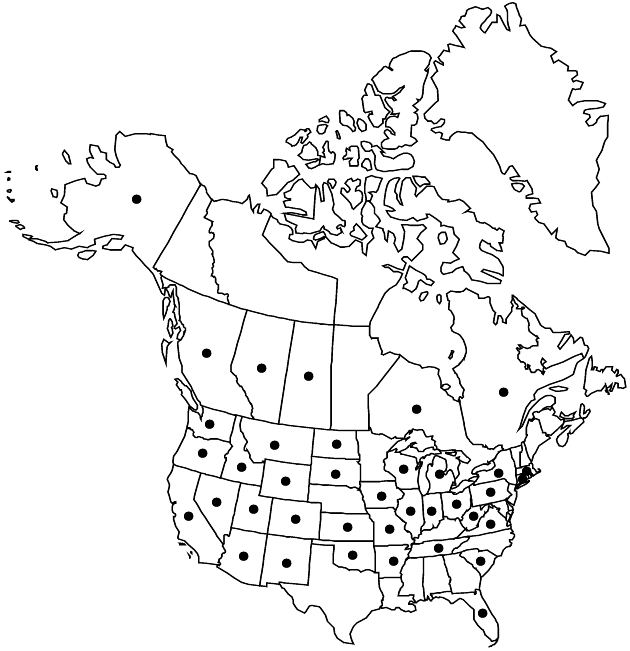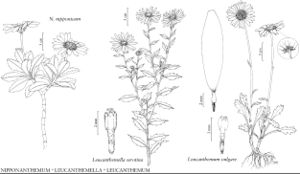Difference between revisions of "Leucanthemum vulgare"
Fl. Franç. 2: 137. 1779.
FNA>Volume Importer |
FNA>Volume Importer |
||
| Line 30: | Line 30: | ||
|elevation=0–2000 m | |elevation=0–2000 m | ||
|distribution=Alta.;B.C.;Ont.;Que.;Sask.;Alaska;Ariz.;Ark.;Calif.;Colo.;Conn.;Fla.;Idaho;Ill.;Ind.;Iowa;Kans.;Mass.;Mich.;Mo.;Mont.;Nev.;N.Mex.;N.Y.;N.Dak.;Ohio;Okla.;Oreg.;Pa.;S.C.;S.Dak.;Tenn.;Utah;Va.;Wash.;W.Va.;Wis.;Wyo.;Europe;widely adventive. | |distribution=Alta.;B.C.;Ont.;Que.;Sask.;Alaska;Ariz.;Ark.;Calif.;Colo.;Conn.;Fla.;Idaho;Ill.;Ind.;Iowa;Kans.;Mass.;Mich.;Mo.;Mont.;Nev.;N.Mex.;N.Y.;N.Dak.;Ohio;Okla.;Oreg.;Pa.;S.C.;S.Dak.;Tenn.;Utah;Va.;Wash.;W.Va.;Wis.;Wyo.;Europe;widely adventive. | ||
| − | |discussion=<p>Some botanists (e.g., W. J. Cody 1996) have treated Leucanthemum ircutianum de Candolle, with blades of mid and distal cauline leaves oblong to oblong-lanceolate and not ± pinnate at bases, as distinct from L. vulgare.</p> | + | |discussion=<p>Some botanists (e.g., W. J. Cody 1996) have treated <i>Leucanthemum</i> ircutianum de Candolle, with blades of mid and distal cauline leaves oblong to oblong-lanceolate and not ± pinnate at bases, as distinct from <i>L. vulgare</i>.</p> |
|tables= | |tables= | ||
|references= | |references= | ||
| Line 55: | Line 55: | ||
|publication year=1779 | |publication year=1779 | ||
|special status= | |special status= | ||
| − | |source xml=https://jpend@bitbucket.org/aafc-mbb/fna-data-curation.git/src/ | + | |source xml=https://jpend@bitbucket.org/aafc-mbb/fna-data-curation.git/src/8f726806613d60c220dc4493de13607dd3150896/coarse_grained_fna_xml/V19-20-21/V19_976.xml |
|tribe=Asteraceae tribe Anthemideae | |tribe=Asteraceae tribe Anthemideae | ||
|genus=Leucanthemum | |genus=Leucanthemum | ||
Revision as of 15:16, 18 September 2019
Perennials, 10–30(–100+) cm. Stems simple or distally branched. Basal leaves: petioles 10–30(–120) mm, expanding into obovate to spatulate blades 12–35(–50+) × 8–20(–30) mm, margins usually pinnately lobed (lobes 3–7+) and/or irregularly toothed. Cauline leaves petiolate or sessile; blades oblanceolate or spatulate to lanceolate or linear, 30–80+ × 2–15+ mm, margins of mid-stem leaves usually irregularly toothed proximally and distally. Involucres 12–20+ mm diam. Phyllaries (the larger) 2–3 mm wide. Ray florets usually 13–34+, rarely 0; laminae 12–20(–35+) mm. Ray cypselae 1.5–2.5 mm, apices usually coronate or auriculate. 2n = 18, 36, 54, 72, 90.
Phenology: Flowering spring–fall.
Habitat: Disturbed places, meadows, seeps, clearings
Elevation: 0–2000 m
Distribution

Alta., B.C., Ont., Que., Sask., Alaska, Ariz., Ark., Calif., Colo., Conn., Fla., Idaho, Ill., Ind., Iowa, Kans., Mass., Mich., Mo., Mont., Nev., N.Mex., N.Y., N.Dak., Ohio, Okla., Oreg., Pa., S.C., S.Dak., Tenn., Utah, Va., Wash., W.Va., Wis., Wyo., Europe, widely adventive.
Discussion
Some botanists (e.g., W. J. Cody 1996) have treated Leucanthemum ircutianum de Candolle, with blades of mid and distal cauline leaves oblong to oblong-lanceolate and not ± pinnate at bases, as distinct from L. vulgare.
Selected References
None.
